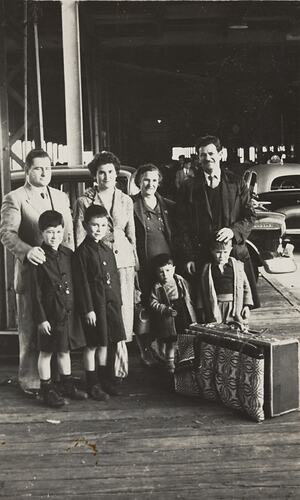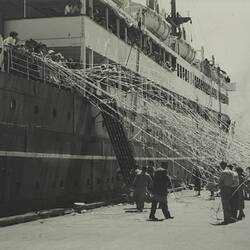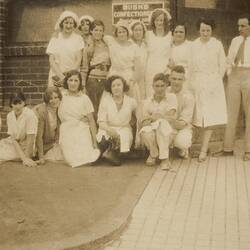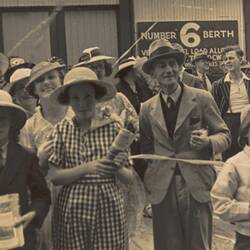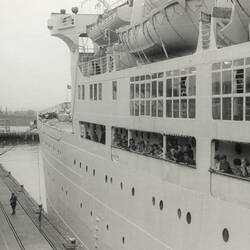With the discovery of gold in the 1850s, Victoria's population exploded. Thousands of hopefuls came pouring into Melbourne. The previous system of ferrying people and luggage upriver from ships anchored in Hobsons Bay or dropping them on the beach to travel overland to Melbourne had become completely inadequate. The expense of double handling and loss of goods was a signal that a new solution was needed.
Melbourne's First Piers
The Melbourne and Hobsons Bay Railway Company conceived of a scheme to link Melbourne to the bay with a railway line (it would be Melbourne's first railway line) and a large, deep water pier in Hobsons Bay. Due to its proximity to Melbourne, the swampland of Sandridge (now named Port Melbourne) was chosen for the location of this new pier, which opened as Railway Pier, in 1854.
This pier served Victoria for over 70 years, and saw the comings and goings of hundreds of thousands of people. The port was in need of an overhaul, so in the early 20th century, the Melbourne Harbour Trust began construction on New Railway Pier (now called Princes Pier).
Although it wasn't officially completed until 1916, New Railway Pier was the departure point of the first Australian troops bound for the World War I battlefields in 1914. This pier also saw the homecoming of most of the troops who returned to Australia.
Station Pier
Once New Railway Pier was completed, work could begin on transforming Railway Pier into the more modern Station Pier. The makeover took seven years, during which time ships, their passengers and cargo were diverted to New Railway Pier or the river docks. By 1930, Station Pier was ready for business. The Orient Line steamer Otranto was the first vessel to officially berth at the newly-completed pier.
Migration slowed during the Second World War, and migrant ships were redeployed to war service as armed cruisers, floating hospitals and troop ships. The pier, once again, became a departure point for Australian troops.
The first displaced people from Europe arrived at Station Pier aboard the HMAS Kanimbla in 1947. Many ships that had carried soldiers were hastily converted to meet an urgent demand for migrant transportation, but still passenger comforts on such ships were extremely limited. Large empty holds were fitted out with double or triple-tiered bunks. The food was plain and sometimes inadequate, and overcrowding was a common complaint. Everyone, including families, was split into separate men's and women's quarters.
Ale Liubinas, who migrated from Lithuania in 1949 remembers that the ship was "clean and well maintained, but had no luxuries, as it was designed to carry American troops during the war. The dormitories were crowded with bunks. It had communal toilets and salt-water showers. Our only treat was the refrigerated drinking water tap in the passage, but it broke down after a few days at sea."
When a migrant ship steamed into dock, Station Pier erupted into action. There were immigration and customs officials, baggage handlers and delivery personnel, photographers, industry representatives spruiking for new recruits, welcoming parties and sightseers. Hostesses employed by the Harbour Trust known as the 'blue ladies' were on hand to guide and assist, while community organisations such as the Travellers Aid Society provided support, especially for the more needy. Inside the terminal the shops and information booths opened for business.
The End of the Migrant Ship Era
Two important developments in the 1960s led to a decline in the use of Australian ports and changed migrant journeys to Australia forever. Firstly, the advent of container shipping eliminated the need for cargo nets and dozens of stevedores to load and unload the ships. Moreover, cargo shipping now required purpose-built vessels and specialised cranes that many of the older piers and wharves could not accommodate. These changes also affected migrant ships that had previously relied on cargo to finance their return voyages.
The second technological development was a growing preference for air travel. By the 1970s, under-utilised migrant ships were finding a new life as cruise liners. The last government assisted migrant ship to come to Australia was the Australis in 1977. Its departure ended a long and important chapter in Australian migration. In 1987 the train line to Port Melbourne was converted to light rail, becoming part of Melbourne's tram system.
Station Pier still welcomes thousands of passengers to Melbourne. It is the city's main terminal for international cruise ships and was the home of the Spirit of Tasmania passenger ferry until 2023. It also continues to be an ongoing symbol for the immigrants who arrived there.
More Information
-
Keywords
Station Pier, Migration & Settlement, Immigrant Voyages, Migrants, World War II, 1939-1945
-
Authors
-
Article types
